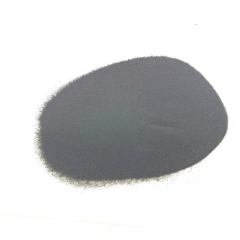Types of metal alloy powder
Alloy powder is a metal powder formed by partial or complete alloying of two or more components. According to the composition classification, alloy powders mainly include iron alloy powder, copper alloy powder, nickel alloy powder, cobalt alloy powder, aluminum alloy powder, titanium alloy powder and precious metal alloy powder. The pre-alloyed powder is usually prepared by the atomization powdering method, and it is a completely alloyed powder composed of solid solution and intermetallic compound. All alloys that can be melted and liquefied can be made into powder by the atomization powdering method.

Properties of Nitinol powder
Nitinol titanium powder is a shape memory alloy, a special alloy that can automatically restore its plastic deformation to its original shape at a certain temperature and has good plasticity.
Application of alloy powder
Titanium alloy powder is prepared by rotating electrode atomization powder method or inert gas atomization method, and its chemical composition includes Ti-6A1-4V and Ti-6Al-6V-2Sn. These titanium alloy powder can be formed into near-net-shaped special-shaped components and disks with theoretical density at one time using hot isostatic pressing technology. These products have been used in aero engines, fighter jets and helicopters. Titanium alloy powder can also be used to make medical inlaid bones.
How to produce Nitinol Nitinol Nitinol powder?
Nitinol is extremely difficult to produce due to the need for very strict composition control and excellent titanium reactivity. Every atom in titanium that binds to oxygen or carbon is taken from the NiTi lattice, which changes the composition and lowers the phase transition temperature. There are two main melting methods:
Vacuum arc remelting (VAR)
This is achieved by generating an arc between the raw material and the water-cooled copper contact plate. The melting is done under high vacuum, and the mold itself is water-cooled copper.
Vacuum induction melting (VIM)
This is done by heating the raw material in a crucible (usually carbon) using an alternating magnetic field. This is also done under high vacuum.
Although these two methods have their advantages, it has been proven that compared with the VART smelting process, the VIM smelting process material has fewer inclusions and therefore has higher fatigue resistance. Other research reports point out that the use of ultra-high purity plasticizers in raw materials can reduce the number of inclusions and improve fatigue performance. Other methods can also be used on a boutique scale, including plasma arc melting, induction skull melting, and electron beam melting. Physical vapor deposition is also used on a laboratory scale.
Hot processing of Nitinol is relatively easy, but cold processing is difficult, because the huge elasticity of the alloy increases the contact between the mold or the roller, which leads to huge frictional resistance and tool wear. For similar reasons, processing is very difficult, and to make matters worse, the thermal conductivity of Nitinol is very poor, so it is difficult to dissipate heat. Grinding (abrasive cutting), electrical discharge machining (EDM) and laser cutting are all relatively easy.
Application of Ni-Ti alloy powder
Nitinol alloy contains 50% nickel and 50% titanium, that is to say, nickel and titanium are equally divided, each accounting for half. The temperature range of the shape memory can be adjusted by the control component. Generally, the higher the nickel content of Nitinol, the lower the operating temperature. When it contains 55% nickel and 45% titanium, the memory alloy can work at room temperature.
People have used this characteristic of shape memory alloys to make pearl necklaces and bracelets made of shape memory alloy wires, and bras woven from shape memory alloy wires. Wearing these decorations and health products on the body will restore the original curvature and rigidity under the action of body temperature, thus playing a role of decoration and health care. In addition, you can also use Nitinol to make orthodontic wires to correct deformed teeth based on the body's oral temperature.
Nitinol can be used to replace traditional actuators (solenoid valves, servo motors, etc.), such as the simple hexapod robot Stiquito.
Nitinol springs are used in fluid thermal valves, where the material acts as both a temperature sensor and an actuator.
The alloy is used as an auto-focus actuator in sports cameras and as an optical image stabilizer in mobile phones.
Alloys are used in pneumatic valves to obtain a comfortable seat, which has become an industry standard.
The price of Ni-Ti alloy powder
TRUNNANO (aka. Luoyang Tongrun Nano Technology Co. Ltd.) is a trusted global chemical material supplier & manufacturer with over 12 years of experience in providing super high-quality chemicals and Nanomaterials. Currently, our company has successfully developed a series of powder materials. OEM service is available. If you are looking for alloy powder, please contact us. Or click on the needed products to send us an inquiry.


